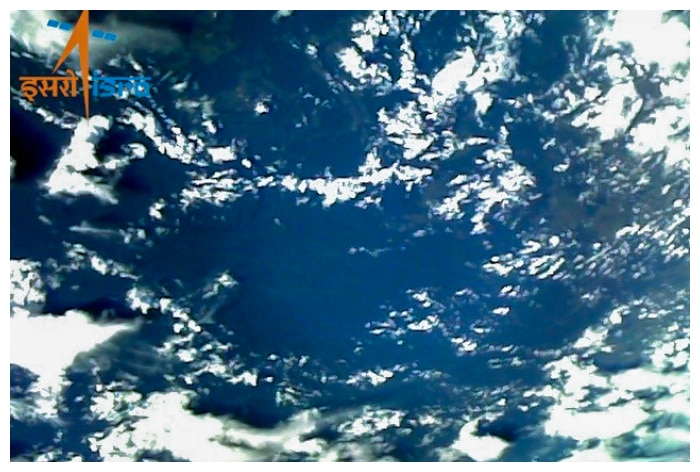
[ad_1]
Now Chandrayaan has come in an orbit of 150 Km x 177 Km. That is, Chandrayaan-3 is moving in such an orbit of the Moon, in which its minimum distance from the Moon is 150 Km and the maximum distance is 177 Km.

Chandrayaan-3 Update: The Indian Space Research Organization (ISRO) reduced the orbit of Chandrayaan-3 for the third time today, i.e., on 14 August. Now Chandrayaan has come in an orbit of 150 Km x 177 Km. That is, Chandrayaan-3 is moving in such an orbit of the Moon, in which its minimum distance from the Moon is 150 Km and the maximum distance is 177 Km. The vehicle’s engines were briefly switched on to lower the orbit.
Now the orbit circularization phase of Chandrayaan has started. That is, Chandrayaan has started coming from the elliptical orbit to the circular orbit. ISRO will now perform the next operation on August 16 at 08:30 am. In this, scientists from ISRO’s headquarters in Bengaluru will fire Chandrayaan’s thrusters and bring it into a circular orbit of 100 Km X 100 Km.
August 17 is a very important day for Chandrayaan. On this day ISRO will separate the propulsion module of Chandrayaan-3 from the lander. Then on August 23, at around 05:30 pm, the lander will land on the lunar surface. Earlier on August 9, the orbit of Chandrayaan was reduced, after which it came into an orbit of 174 Km x 1437 Km.
The Vehicle Reached The Moon’s Orbit On August 5
After a journey of 22 days, Chandrayaan reached the Moon’s orbit on August 5 at around 7:15 pm. Then the vehicle could be captured in the gravity of the Moon and its speed was reduced. To reduce the speed, ISRO scientists turned the face of the vehicle and fired the thrusters for 1835 seconds, i.e., for about half an hour.
Earlier, on August 6, at around 11 pm, Chandrayaan’s orbit was reduced for the first time. Then it came into the orbit of 170 Km x 4313 Km of the Moon. To reduce the speed, ISRO scientists turned the face of the vehicle and fired the thrusters for 1835 seconds, i.e., for about half an hour.
Chandrayaan Captured Moon’s Pictures
When Chandrayaan entered the Moon’s orbit of 164 Km x 18,074 Km, its onboard cameras captured pictures of the Moon. ISRO made a video of it and shared it on its website. The craters of the moon are clearly visible in these pictures.
Chandrayaan-3 Felt The Gravity Of The Moon
Giving information about the mission, ISRO had written the message sent by Chandrayaan in the X post, “I am Chandrayaan-3. I am feeling the gravity of the moon.” ISRO had also told that Chandrayaan-3 has been successfully placed in the Moon’s orbit. Chandrayaan has to reduce its orbit a total of 4 times before landing on 23 August. It has reduced the orbit once on Sunday.
Thrusters were fired when Chandrayaan was closest to the Moon in orbit. ISRO had informed that the retro-burning at Perilune was commanded from the Mission Operations Complex (MOX), ISTRAC, Bengaluru. Perilune is the point at which a vehicle in lunar orbit is closest to the Moon.
Chandrayaan-3 Left Earth’s Orbit For Moon On August 1
Chandrayaan-3 was sent from the Earth’s orbit towards Moon on August 1 at around midnight. This is called a translunar injection. Earlier, Chandrayaan was moving in such an elliptical orbit whose minimum distance from the earth was 236 km and the maximum distance was 1 lakh 27 thousand 603 km.
Engines Were Briefly Ignited For Translunar Injection
For translunar injection, scientists from ISRO’s headquarters in Bengaluru started Chandrayaan’s engine for some time. Engine firing was done when Chandrayaan was at a distance of 236 km from the Earth. ISRO had said: “Chandrayaan-3 is moving towards the Moon after completing its orbit around the Earth. ISRO has placed the spacecraft in the translunar orbit”.
Lander And Rover Will Conduct Experiments On The Moon For 14 Days
Chandrayaan-3 has Lander, Rover, and Propulsion Module. The lander and rover will land on the Moon’s South Pole and conduct experiments there for 14 days. The propulsion module will study the radiation coming from the Earth by staying in the Moon’s orbit. Through this mission, ISRO will find out how earthquakes occur on the lunar surface. It will also study the lunar soil.
Chandrayaan-3: The Journey So Far
On July 14, Chandrayaan-3 was launched into an orbit of 170 km x 36,500 km.
The orbit was increased to 41,762 km x 173 km for the first time on 15 July.
On 17 July, the orbit was increased for the second time to 41,603 km x 226 km.
On 18 July, the orbit was increased for the third time to 5,1400 km x 228 km.
On 20 July, the orbit was increased for the fourth time to 71,351 x 233 Km.
On 25 July, the orbit was increased for the fifth time to 1.27,603 km x 236 km.
The Moon left Earth’s orbit at midnight between July 31 and August 1.
On August 5, Chandrayaan-3 entered the Moon’s orbit of 164 Km x 18074 Km.
On August 6, Chandrayaan’s orbit was reduced to 170 Km x 4313 Km.
On August 9, Chandrayaan’s orbit was reduced to 174 km x 1437 km for the second time.
On August 14, Chandrayaan’s orbit was reduced to 150 Km x 177 Km for the third time.
Chandrayaan-3 will land on the moon on 23 August.

Don’t Miss Out on the Latest Updates.
Subscribe to Our Newsletter Today!

[ad_2]